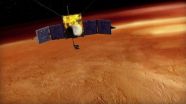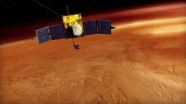(Press-News.org) The Red Planet bleeds. Not blood, but its atmosphere, slowly trickling away to space. The culprit is our sun, which is using its own breath, the solar wind, and its radiation to rob Mars of its air. The crime may have condemned the planet's surface, once apparently promising for life, to a cold and sterile existence.
Features on Mars resembling dry riverbeds, and the discovery of minerals that form in the presence of water, indicate that Mars once had a thicker atmosphere and was warm enough for liquid water to flow on the surface. However, somehow that thick atmosphere got lost in space. It appears Mars has been cold and dry for billions of years, with an atmosphere so thin, any liquid water on the surface quickly boils away while the sun's ultraviolet radiation scours the ground.
Such harsh conditions are the end of the road for known forms of life. Although it's possible that martian life went underground, where liquid water may still exist and radiation can't reach.
The lead suspect for the theft is the sun, and its favorite M.O. may be the solar wind. All planets in our solar system are constantly blasted by the solar wind, a thin stream of electrically charged gas that continuously blows from the sun's surface into space. On Earth, our planet's global magnetic field shields our atmosphere by diverting most of the solar wind around it. The solar wind's electrically charged particles, ions and electrons, have difficulty crossing magnetic fields.
"Mars can't protect itself from the solar wind because it no longer has a shield, the planet's global magnetic field is dead," said Bruce Jakosky of the University of Colorado, Boulder. Jakosky is the Principal Investigator for NASA's MAVEN mission, which will investigate what is responsible for the loss of the martian atmosphere. NASA selected the MAVEN (Mars Atmosphere and Volatile Evolution Mission) on September 15, 2008.
Mars lost its global magnetic field in its youth billions of years ago. Once its planet-wide magnetic field disappeared, Mars' atmosphere was exposed to the solar wind and most of it could have been gradually stripped away. "Fossil" magnetic fields remaining in ancient surfaces and other local areas on Mars don't provide enough coverage to shield much of the atmosphere from the solar wind.
Although the solar wind might be the primary method, like an accomplished burglar, the sun's emissions can steal the martian atmosphere in many ways. However, most follow a basic M.O., the solar wind and the sun's ultraviolet radiation turns the uncharged atoms and molecules in Mars' upper atmosphere into electrically charged particles (ions). Once electrically charged, electric fields generated by the solar wind carry them away. The electric field is produced by the motion of the charged, electrically conducting solar wind across the interplanetary, solar-produced magnetic field, the same dynamic generators use to produce electrical power.
An exception to this dominant M.O. are atoms and molecules that have enough speed from solar heating to simply run away, they remain electrically neutral, but become hot enough to escape Mars' gravity. Also, solar extreme ultraviolet radiation can be absorbed by molecules, breaking them into their constituent atoms and giving each atom enough energy that it might be able to escape from the planet.
There are other suspects. Mars has more than 20 ancient craters larger than 600 miles across, scars from giant impacts by asteroids the size of small moons. This bombardment could have blasted large amounts of the martian atmosphere into space. However, huge martian volcanoes that erupted after the impacts, like Olympus Mons, could have replenished the martian atmosphere by venting massive amounts of gas from the planet's interior.
It's possible that the hijacked martian air was an organized crime, with both impacts and the solar wind contributing. Without the protection of its magnetic shield, any replacement martian atmosphere that may have issued from volcanic eruptions eventually would also have been stripped away by the solar wind.
Earlier Mars spacecraft missions have caught glimpses of the heist. For example, flows of ions from Mars' upper atmosphere have been seen by both NASA's Mars Global Surveyor and the European Space Agency's Mars Express spacecraft.
"Previous observations gave us 'proof of the crime' but only provided tantalizing hints at how the sun pulls it off — the various ways Mars can lose its atmosphere to solar activity," said Joseph Grebowsky of NASA's Goddard Space Flight Center in Greenbelt, Md. "MAVEN will examine all known ways the sun is currently swiping the Martian atmosphere, and may discover new ones as well. It will also watch how the loss changes as solar activity changes over a year. Linking different loss rates to changes in solar activity will let us go back in time to estimate how quickly solar activity eroded the Martian atmosphere as the sun evolved." Grebowsky is the Project Scientist for MAVEN.
As the martian atmosphere thinned, the planet got drier as well, because water vapor in the atmosphere was also lost to space, and because any remaining water froze out as the temperatures dropped when the atmosphere disappeared. MAVEN can discover how much water has been lost to space by measuring hydrogen isotope ratios.
Isotopes are heavier versions of an element. For example, deuterium is a heavy version of hydrogen. Normally, two atoms of hydrogen join to an oxygen atom to make a water molecule, but sometimes the heavy and rare, deuterium takes a hydrogen atom's place.
On Mars, hydrogen escapes faster because it is lighter than deuterium. Since the lighter version escapes more often, over time, the martian atmosphere has less and less hydrogen compared to the amount of deuterium remaining. The martian atmosphere therefore becomes richer and richer in deuterium.
The MAVEN team will measure the amount of hydrogen compared to the amount of deuterium in Mars' upper atmosphere, which is the planet's present-day hydrogen to deuterium (H/D) ratio. They will compare it to the ratio Mars had when it was young -- the original H/D ratio. The original ratio is estimated from observations of the H/D ratio in comets and asteroids, which are believed to be pristine, "fossil" remnants of our solar system's formation.
Comparing the present and original H/D ratios will allow the team to calculate how much hydrogen, and therefore water, has been lost over Mars' lifetime. For example, if the team discovers the martian atmosphere is ten times richer in deuterium today, the planet's original quantity of water must have been at least ten times greater than that seen today.
MAVEN will also help determine how much martian atmosphere has been lost over time by measuring the isotope ratios of other elements in the air, such as nitrogen, oxygen, and carbon.
MAVEN is scheduled for launch between November 18 and December 7, 2013. If it is launched November 18, it will arrive at Mars on September 16, 2014 for its year-long mission.
INFORMATION:
MAVEN is part of NASA's Mars Scout program, funded by NASA Headquarters in Washington, DC. The University of Colorado will coordinate the science team and science operations. NASA Goddard will manage the project and provide mission systems engineering, mission design, and safety and mission assurance. NASA's Jet Propulsion Laboratory, Pasadena, Calif., will navigate the spacecraft, provide the Deep Space Network, and an Electra telecommunications relay package. Instruments on the spacecraft will be provided by the University of California, Berkeley, the University of Colorado, Boulder, and NASA Goddard, with the Centre d'Etude Spatiale des Rayonnements, Toulouse, France, providing the sensor for one instrument. Lockheed Martin Corp., Bethesda, Md., will develop the spacecraft, conduct assembly, test and launch operations, and provide mission operations at their Littleton, Colorado facility.
To see the related press release, click here:
www.nasa.gov/centers/goddard/news/releases/2010/10-087.html
MAVEN mission to investigate how sun steals Martian atmosphere
2010-10-06
ELSE PRESS RELEASES FROM THIS DATE:
NASA'S Mars atmosphere mission given the green light to proceed to development
2010-10-06
GREENBELT, Md. – NASA's mission to investigate the mystery of how Mars lost much of its atmosphere passed a critical milestone on October 4, 2010. NASA has given approval for the development and 2013 launch of the Mars Atmosphere and Volatile Evolution (MAVEN) mission.
Clues on the Martian surface, such as features resembling dry riverbeds and minerals that only form in the presence of liquid water, suggest that Mars once had a denser atmosphere, which supported the presence of liquid water on the surface. As part of a dramatic climate change, most of the Martian atmosphere ...
Phillies, Rangers, Yanks, Giants to win, says NJIT math guru
2010-10-06
With the Major League Baseball Division Series set to begin, associate math professor Bruce Bukiet at NJIT is performing his analysis of the probability of each team advancing to the League Championship Series. "Going into these series, the Philadelphia Phillies have a 64 percent chance of defeating the Cincinnati Reds in their best of five game series," he said.
"The Texas Rangers, New York Yankees and San Francisco Giants have slight advantages to win series over their opponents, the Tampa Bay Rays, Minnesota Twins and Atlanta Braves respectively in the first round ...
Blood test could diagnose Alzheimer's disease, UT Southwestern researchers find
2010-10-06
DALLAS – Oct. 6, 2010 – A set of proteins found in blood serum shows promise as a sensitive and accurate way to diagnose Alzheimer's disease, researchers at UT Southwestern Medical Center have found as part of a statewide study.
An analysis of the proteins, plus a clinical exam, proved 94 percent accurate in detecting suspected Alzheimer's and 84 percent accurate in ruling it out in people without the disease, the researchers said.
"This research uses a novel technology that makes it possible to analyze several biomarkers in a single blood sample in a cost-effective ...
Low testosterone linked to Alzheimer's disease
2010-10-06
ST. LOUIS -- Low levels of the male sex hormone, testosterone, in older men is associated with the onset of Alzheimer's disease, according to research by a team that includes a Saint Louis University scientist.
"Having low testosterone may make you more vulnerable to Alzheimer's disease," said John E. Morley, M.D., director of the division of geriatric medicine at Saint Louis University and a study co-investigator. "The take-home message is we should pay more attention to low testosterone, particularly in people who have memory problems or other signs of cognitive impairment."
The ...
Childrens Hospital LA discovers growth factor essential to epicardial cell function
2010-10-06
LOS ANGELES– In research that one day may lead to the discovery of how to regenerate tissue damaged by heart disease, investigators at Childrens Hospital Los Angeles have identified PDGF as a key factor in the proliferation and transformation of epicardial cells, one type of cell that surrounds heart muscle and contributes to vessels.
The study was published online September 21 in advance of the publication of the Proceedings of the National Academy of Sciences of the United States of America. Ching-Ling (Ellen) Lien, PhD, led a team of researchers at the Developmental ...
Study: Fish near coal-fired power plants have lower levels of mercury
2010-10-06
A new study from North Carolina State University finds that fish located near coal-fired power plants have lower levels of mercury than fish that live much further away. The surprising finding appears to be linked to high levels of another chemical, selenium, found near such facilities, which unfortunately poses problems of its own.
"We found that fish in lakes located at least 30 kilometers (km) from a coal-fired power plant had mercury levels more than three times higher than fish of the same species in lakes that are within 10 km of a plant," says Dana Sackett, a Ph.D. ...
Tour d'Afrique's New 2011 Samba Tango Cycling Adventure Dances Through Music-Loving Cultures From Rio de Janeiro to Buenos Aires
2010-10-06
Tour d'Afrique (http://www.tourdafrique.com/), a leader in cross-continent, multi-country cycling tours, invites riders to save space on their dance cards for an Aug. 14 to Sept. 18, 2011, Samba Tango Adventure http://www.tourdafrique.com/tours/sambatango spanning 3,150 km (1,950 miles) in 36 days from Rio de Janeiro to Buenos Aires.
The Full Tour per person rate of $3,900 offers the privilege of averaging 100 km per day in the saddle with six rest and sightseeing days sprinkled in. If full payment is made on or before Feb. 20, 2011, a discount of 5% applies.
Riders ...
The Culinary Studio: Metro Detroit's First Shared-Use Kitchen to Open in Southfield
2010-10-06
Calling all bakers, caterers, personal chefs and aspiring food entrepreneurs - The Culinary Studio will help local food-oriented businesses launch and grow without the burden of start-up costs. Fully equipped kitchens will be available at The Culinary Studio for hourly rental to food entrepreneurs and for special cooking events.
Located in the Applegate Shopping Center on Northwestern Highway in Southfield, Michigan, The Culinary Studio will have two state of the art commercial kitchens, with areas for preparing, packaging, catering and baking along with cooking classes. ...
DPR Construction Honored by American Institute of Architects, California Council
2010-10-06
DPR Construction's (DPR) San Diego regional headquarters was recently honored with an "Award of Merit" for Interior Renovation by the American Institute of Architects California Council and Savings By Design group. The DPR office was recognized for its commitment to resource efficiency, responsibility for the environment, human productivity and quality of life.
"Our San Diego headquarters is a true representation of DPR's culture," said Jay Leopold, regional manager of DPR Construction. "It is important for us to uphold sustainable practices while creating a positive ...
Casmiro Is Now the Leading e-Commerce Video Streaming Company Online
2010-10-06
Casmiro: Casmiro today announced that it has become the #1 Pay-to-Access Video Streaming Company Online. In Q1&Q2 of 2010, Casmiro's customer base grew over 93%, leading them to offering the most successful platform for video publishers looking to monetize their video footage.
Wilbert Jackson of Casmiro states, "Since our private Beta launch in July, we've seen a dramatic spike in video publishers. The numbers prove that the demand for video filmmakers looking to monetize their films online is on the rise. Whether they have video filmed using professional equipment ...




